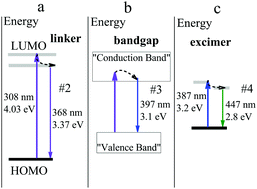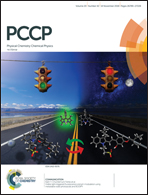Exploring the electronic structure of aluminum metal–organic framework Basolite A100: solid-state synchronous fluorescence spectroscopy reveals new charge excitation/relaxation pathways†
Abstract
We investigated the electronic structure of a metal–organic framework (MOF), for the first time, by solid-state synchronous fluorescence spectroscopy in comparison with “conventional” fluorescence spectroscopy. The solid-state synchronous fluorescence spectra of aluminum MOF Basolite A100 in the UV-visible range at 25 °C are significantly narrower than the commonly used “conventional” fluorescence spectra. More importantly, the solid-state synchronous fluorescence spectra reveal major electronic transitions and fine molecular interactions in the MOF not available from the commonly used analysis. The following distinct pathways of charge excitation, followed by relaxation, are observed in Basolite A100: (a) a narrow resonance due to the monomer of the BDC linker at 308 nm, (b) an optical bandgap at 355 nm, and (c) absorption by excimers due to the ligand-to-ligand charge transfer (LLCT) between the two BDC linkers at ca. 387 nm. Furthermore, we accurately determine the optical bandgap in Basolite A100, for the first time, by solid-state enhanced resolution synchronous (excitation) spectroscopy. Finally, changes in the inter-linker LLCT interactions in the activated and hydrated forms of Basolite A100 are revealed by solid-state enhanced resolution synchronous (excitation) spectroscopy.



 Please wait while we load your content...
Please wait while we load your content...